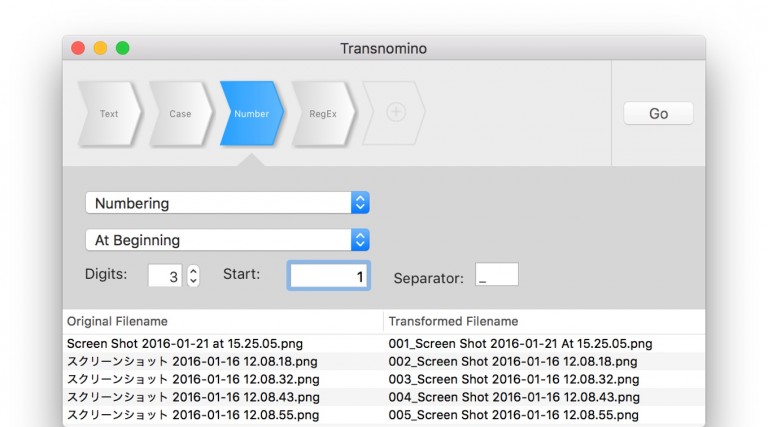
# Try substitute: re.sub( regexStr, replacementStr, inStr) -> outStr # r'.' denotes raw strings which ignore escape code, i.e., r'\n' is '\'+'n' > import re # Need module 're' for regular expression # Try find: re.findall( regexStr, inStr) -> matchedSubstringsList # Test under the Python Command-Line Interpreter Python also uses backslash ( \) for escape sequences (i.e., you need to write \\ for \, \\d for \d), but it supports raw string in the form of r'.', which ignore the interpretation of escape sequences - great for writing regex.
#Transnomino regex full#
See " Python's re module for Regular Expression" for full coverage.
#Transnomino regex code#
There are more than one ways to write a regex! Take note that many programming languages (C, Java, JavaScript, Python) use backslash \ as the prefix for escape sequences (e.g., \n for newline ), and you need to write "\\d+" instead.Ĭode Examples (Python, Java, JavaScript, Perl, PHP) Code Example in Python You can also write \d+, where \d is known as a metacharacter that matches any digit (same as ).Take note that this regex matches number with leading zeros, such as "000", "0123" and "0001", which may not be desirable. If the input is "abcxyz", it matches nothing.If the input is "abc123xyz", it matches substring "123".This regex matches any numeric substring (of digits 0 to 9) of the input.In fact, it could match zero or more substrings of the input (with global modifier). A regex may match a portion of the input (i.e., substring) or the entire input.In this case, + matches one or more digits. The +, known as occurrence indicator (or repetition operator), indicates one or more occurrences ( 1+) of the previous sub-expression.In this example, matches any SINGLE character between 0 and 9 (i.e., a digit), where dash ( -) denotes the range. It matches any SINGLE character in the list. The, known as character class (or bracket list), encloses a list of characters.A regex ( regular expression) consists of a sequence of sub-expressions.E.g., the regex x matches substring "x" regex 9 matches "9" regex = matches "=" and regex matches Special Regex Characters: These characters have special meaning in regex (to be discussed below). Character: All characters, except those having special meaning in regex, matches themselves.For novices, go to the next section to learn the syntax, before looking at these examples. This section is meant for those who need to refresh their memory. Getting started with regex may not be easy due to its geeky syntax, but it is certainly worth the investment of your time. Regex is supported in all the scripting languages (such as Perl, Python, PHP, and JavaScript) as well as general purpose programming languages such as Java and even word processors such as Word for searching texts.

One line of regex can easily replace several dozen lines of programming codes. And if EXIF GPS Longitude and Latitude data is available it is even able to use this information to lookup Address information.Regular Expression, or regex or regexp in short, is extremely and amazingly powerful in searching and manipulating text strings, particularly in processing text files. Transnomino supports insertions of File Attributes from the files like: EXIF, ID3, FLAC. The files in the list can be dragged and dropped to change the order.Īll renaming actions can be applied to the Name, Path or Extension of the files It's possible to exactly specify the number of digits to allow for better sorting of the files by filename. Numbering can be added to the beginning or end of the filename. Renaming sequences can be saved as a recipe to be re-used later. Any number of these actions can be placed in sequence and you can directly preview the results while you create them. Transnomino offers a set of renaming actions, ranging from simple text replacements to more complex replacements using regular expressions (regex).


 0 kommentar(er)
0 kommentar(er)
